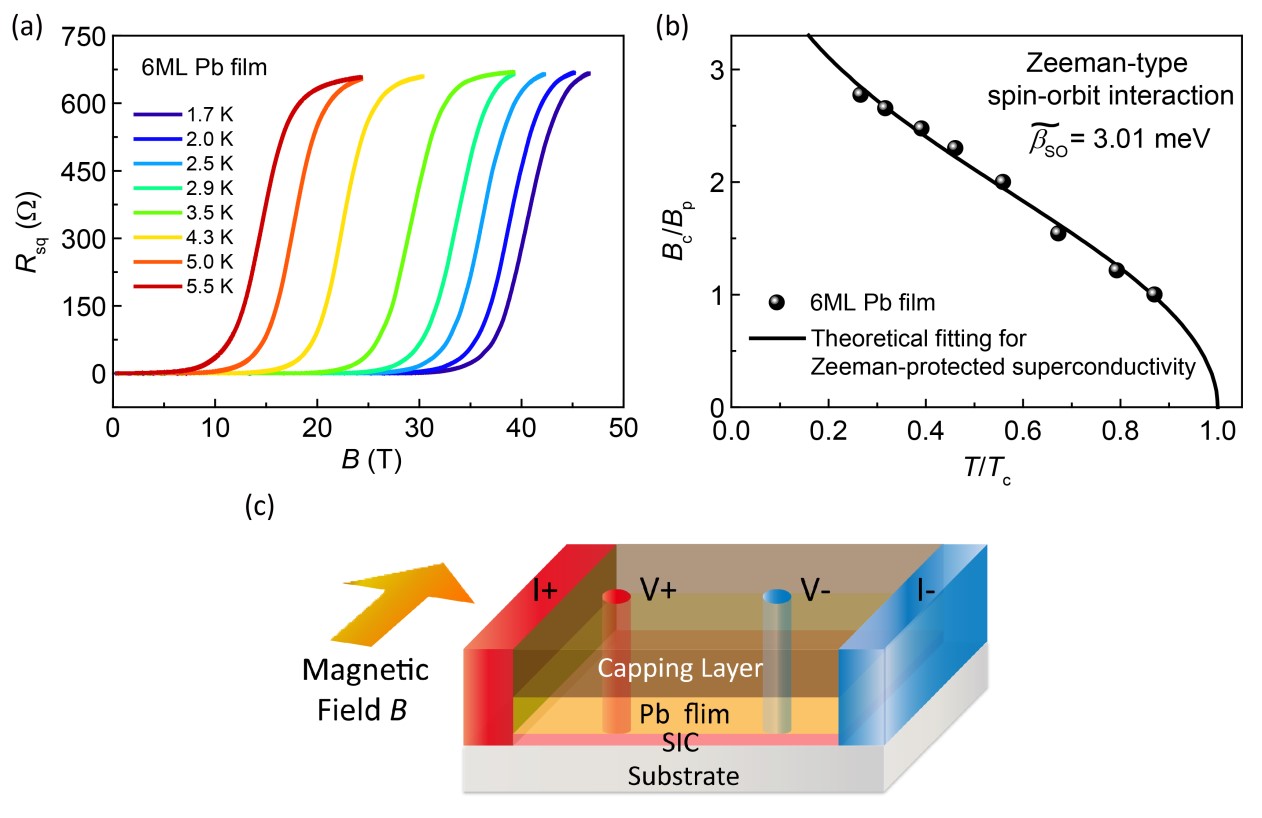Physical Review X reports Jian Wang group and collaborators’ work on the observation of interface-induced Zeeman-protected superconductivity in ultrathin crystalline lead films
Superconductivity, known as a quantum state in which current can flow without resistance, has attracted great attention in both academic and industrial fields. With the development of growing high-quality ultrathin superconducting films, research on two-dimensional crystalline superconductors has become a new frontier in condensed matter physics and materials science. Due to the reduced dimensionality and nanoscale effect, novel quantum phenomena and physics emerge in two-dimensional superconducting systems. For instance, superconducting transition in 2D system was predicted to be a topological KT transition, and related work has been awarded the 2016 Nobel prize in Physics. Moreover, interface can play an important role in the superconducting properties. Jian Wang group at Peking University and collaborators have made a series of progresses in 2D superconductivity research. Representative works include the discovery of quantum Griffiths singularity (Science 350, 542(2015) with a perspective paper Science 350, 509 (2015)), the discovery of a new 2D superconducting phase in Ga films (Physical Review Letters 114, 107003 (2015)) and the demonstration of high-temperature superconductivity in 1-UC FeSe/STO (Chinese Physics Letters 31, 017401 (2014) with a Editors’ Choice paper Science 343, 230 (2014)).
Recently, 2D transition metal dichalcogenides (TMDs), regarded as the materials beyond graphene, have become a highlightaround the world. The investigations on such crystalline 2D superconductors with strong spin-orbit interaction (SOI) have opened up a new direction to explore exotic quantum phenomena. For instance, the broken in-plane inversion symmetry in single layer NbSe2 and gated MoS2 gives rise to Zeeman-type SOI protected superconductivity (Zeeman-protected superconductivity). Its key signature is the large in-plane critical field up to several times of Pauli limit. Prof. Jian Wang and collaborators systematically studied macro-size atomically flat monolayer NbSe2 films grown by molecular beam epitaxy (MBE) method. Ultrahigh magnetic field and low temperature measurements show that the extremely high parallel upper critical field Bc2// (T = 0) of monolayer NbSe2 films significantly exceeds the Pauli paramagnetic limiting field, consistent with Zeeman-protected Ising superconductivity. (Nano Letters 17, 6802 (2017)) Nevertheless, most 2D superconductors naturally preserve the in-plane inversion symmetry and thus the Zeeman-protected superconductivity cannot exist, restricting the scope of related investigations and potential applications.
Recently, Prof. Jian Wang, Prof. Xincheng Xie and Prof. Ji Feng at Peking University, in collaboration with Prof. Haiwen Liu at Beijing Normal University, Prof. Junfeng Wang at Wuhan National High Magnetic Field Center, as well as Prof. Mingliang Tian, Dr. Chuanying Xi at Heifei High Magnetic Field Laboratory of the Chinese Academy of Sciences demonstrated that a new kind of Zeeman-protected superconducting system can be artificially created in the macroscopic scale by inserting striped incommensurate (SIC) phase at the interface between ultrathin crystalline lead film and Si(111) substrate through molecular beam epitaxy (MBE) techhique. By performing systematic transport measurements at low temperatures and ultrahigh magnetic fields, it is found that the superconductivity can survive under a large parallel magnetic field up to 40 T far beyond the Pauli limit, providing clear evidence of Zeeman-protected superconductivity in the Pb/SIC/Si heterostructure. The ab initio calculations demonstrate that the lattice distortion in SIC phase can extend to the neighboring lead film and induce considerable Zeeman-type SOI in the system. Furthermore, a general microscopic theory for the in-plane critical field of two-dimensional dirty superconductivity with various kinds of SOI and spin-orbit scattering is developed to quantitatively illuminate the underlying physical mechanism for the Zeeman-protected superconductivity. The work shows that by interface engineering Zeeman-protected superconductivity can be artificially induced in crystalline 2D superconducting heterostructures. The findings not only provide a new platform to create in-plane inversion symmetry breaking superconducting system, but may also stimulate further studies on the interface modulation of unconventional superconductivity in 2D heterostructures.
The paper was published in Physical Review X on April 2, 2018 (Physical Review X 8, 021002 (2018) DOI: 10.1103/PhysRevX.8.021002): https://journals.aps.org/prx/abstract/10.1103/PhysRevX.8.021002.
Prof. Jian Wang at Peking University and Prof. Haiwen Liu at Beijing Normal University are corresponding authors of this paper. Yi Liu and Ziqiao Wang at Peking University contributed equally to this work.
This work was supported by the National Basic Research Program of China, the National Natural Science Foundation of China, the Open Project Program of the Pulsed High Magnetic Field Facility at Huazhong University of Science and Technology, Collaborative Innovation Center of Quantum Matter, the Key Research Program of the Chinese Academy of Sciences, CAS Center for Excellence in Topological Quantum Computation and the Fundamental Research Funds for the Central Universities. Jian Wang would like to thank Xincheng Xie, Fa Wang, Limei Xue, Zefeng Ren and Collaborative Innovation Center of Quantum Matter for the lab space and patial funding support on the ultrahigh vacuum molecular beam epitaxy and low temperature scanning tunneling microscopy (UHV-MBE-LT STM) system.
Figure (a) Superconductivity in 6 monolayer (ML) Pb film survives at high parallel magnetic field up to 40 T at 1.7 K. (b) Experiments and analysis demonstrate the Zeeman-protected superconductivity in ultrathin Pb films. (c) Schematic for magnetoresistance measurements in epitaxial Pb film on silicon substrate with SIC interface.
